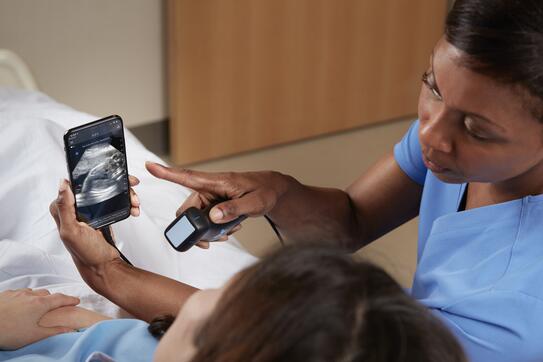Ultrasound machines are vital to diagnosing many medical issues; yet despite widespread use, they are prohibitively expensive and hard to transport, making this crucial test inaccessible to millions of people in the US and around the world.
But now, a new healthcare company, Butterfly, has entered the industry with a handheld, portable ultrasound machine that costs a fraction of the price and that experts say could revolutionize diagnostic medicine.
While traditional ultrasound devices use fragile, expensive crystals to capture images, Butterfly ultrasounds use a single silicon chip to produce scans, a technology that is exponentially cheaper and easier to transport. Butterfly wands, which are small enough to be held in the palm of one’s hand, can be plugged directly into a smartphone, opening up a multitude of possibilities that previously didn’t exist for ultrasound imaging. This life-changing innovation has not gone unnoticed, with such news outlets as the New York Times spotlighting Butterfly’s impact in Africa.
Shannon Cusick ’11, head of business development at Butterfly, says that the company’s ultrasound machines have the potential to upend how healthcare functions and, most importantly, can assist in the democratization of the healthcare system by providing more widespread care. Read on for more about Butterfly’s social impact and how the company plans to one day be in the hands of 40 million medical practitioners around the world.

Shannon Cusick '11
How did you find Butterfly?
I’ve been in the tech industry for about 15 years — I love bringing digital innovations to market. In my previous position at Spotify, I was the director of business development. When I felt ready to leave Spotify, I looked for roles in industries that hadn't experienced a seismic disruption in decades. Inspired by personal stories, I focused on healthcare technologies that aim to detect chronic conditions earlier. I came across Butterfly and was sold on it the first time I saw the product. Coming to Butterfly has been an awesome overlap between a lot of the things I’ve prepared for in my career: it has a subscription software business, global impact, and rapidly scaling technological innovation. One of the unique things about Butterfly is that it has opened up medical-device distribution to ecommerce channels; my role, in part, is to figure out our global strategy for distribution. There’s the science of medical care, and then there’s the culture. Part of my job is navigating how to introduce our product to different markets around the world in a way that recognizes cultural differences in healthcare.
How does Butterfly work and what makes it different?
What Butterfly does that’s so innovative is democratize access to medical imaging, specifically ultrasound. Two-thirds of the world doesn’t have access to imaging — it’s crazy to even think about. Butterfly enables access by relieving three pain points: affordability, portability, and ease of use. We’ve reinvented ultrasound from the ground up using a single silicon chip to replace fragile piezoelectric crystals used in traditional machines. When it comes to price, a typical ultrasound machine costs around $50,000. Our device fits in your pocket and costs $2,000. We‘ve also designed software that uses artificial intelligence and machine learning to help people position, capture, and draw insights from an image. The software allows healthcare professionals to communicate with each other and notate images. The device can be plugged into a smartphone and the images seen directly on the phone, so it’s more portable than traditional ultrasounds.
Who are your customers?
I think that what’s so interesting from a business perspective is that the innovation in our product has expanded who our addressable market can be. We want to get Butterfly into the hands of 40 million medical practitioners around the world and our device has enabled us to think differently. You could see our devices in an obstetrician’s office, in nursing homes, in emergency rooms, or even in a medivac helicopter or on the sidelines of a professional sports game. There are so many applications for ultrasound that were previously hindered by cost, size, and ease of use, all of which we’ve overcome.
What social impact projects is the company is involved with?
We are in 19 countries today and will soon be in even more. Since most of the world does not have access to medical imaging — in some parts of the world the nearest ultrasound machine or doctor may be hours away — we have the chance to have a huge impact on health in the developing world. Butterfly works closely with Bridge to Health to allow medical professionals in Kenya to use our devices to provide early diagnosis through medical imaging for people in remote villages. Butterfly also works with some of the top US medical universities to enhance education through ultrasound for current medical students. We also have a great relationship with the Gates Foundation, who are investors in Butterfly.
How can Butterfly help to democratize healthcare in the US and across the globe?
When we talk about democratizing healthcare, a lot of people immediately think about crossing oceans; the reality is that healthcare is an unwieldy issue in the US, too. What Butterfly can do to democratize healthcare is lower the costs on treatments, monitoring, and management, especially for chronic conditions in our backyard. If a doctor in rural America can carry Butterfly wherever she goes, then a patient can receive care in the comfort of their own home rather than being sent elsewhere for imaging.
